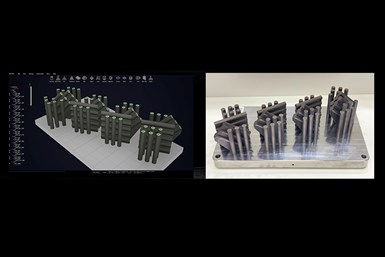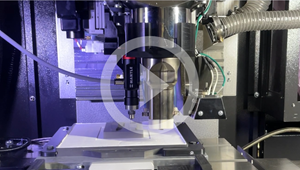Dyndrite, Constellium, Elementum 3D, Sandvik Establish Materials Consortium for 3D Metal Printing
This joint effort aims to make laser bed power fusion (LPBF) powder parameters and related testing data for common materials freely and publicly available to end users, enabling increased knowledge sharing, better outcomes, and faster adoption of materials and techniques.
Photo Credit: Dyndrite
Dyndrite has joined with additive manufacturing (AM) materials producers Constellium, Elementum 3D and Sandvik to establish an industry-led, Materials Consortium for AM. The joint effort is designed to make laser bed power fusion (LPBF) powder parameters and related testing data for common materials freely and publicly available to end users, enabling increased knowledge sharing, better outcomes, and faster adoption of materials and techniques.
The consortium has committed to providing materials parameter sets for LPBF 3D printers. The print parameter sets and related material test data will be contributed to the ASTM Consortium for Materials Data and Standardization (CMDS) initiative and for public access. This access enables accelerated qualification of materials, as well as rapid experimentation and iteration. The consortium plans to work with other metal and plastic powder providers to grow the list of publicly available materials parameters.
Dyndrite is a provider of the GPU-accelerated computation engine used to create next-generation digital manufacturing hardware and software.
With the increasing use of AM parts, especially 3D printed metal parts, the consortium says users are demanding more choice and flexibility in acquiring, innovating and adapting various materials to their particular applications. Along with the growing capabilities of 3D printing machines, the industry requires knowledge sharing and standardization to accelerate and grow market adoption.
Dyndrite has joined with the LPBF materials suppliers to increase the accessibility of tested parameter sets by improving the public’s access to their most common and frequently used material parameters, and testing data.
“Materials are a key pillar of additive manufacturing," says Harshil Goel, Dyndrite CEO. “Unfortunately, maximizing the capabilities of a material, especially as it relates to the geometry being printed, is a black art within our industry. If additive is to become a mainstream manufacturing process, users require transparency and standardization. Public access to a set of trusted, democratized parameters shines a light on the path of adoption.”
SLM Solutions says the business case for being an open architecture metal 3D solution provider is at its core about making customers more successful. “It’s about creating choices for our customers and acknowledging that we can go further, together,” says Garett Purdon, vice president of sales for the Americas at SLM Solutions.
Sandvik has manufactured metal powder for about 45 years and powder for laser powder bed fusion specifically for more than 20 years. “We look forward to working with Dyndrite, Constellium and Elementum 3D to increase users’ access to the knowledge that unlocks the full potential of AM materials,” says Andrew Coleman, head of Additive Manufacturing, Sandvik. “We are excited to be a founding member of a group determined to help users, machine vendors and material suppliers.”
The Materials Consortium will make it easier for customers to benefit from high-performance materials designed specifically for laser powder bed fusion. “This will help accelerate adoption of aluminum AM across multiple LPBF platforms to produce higher performance components at lower qualification cost and lower production cost,” says Ravi Shahani, chief engineer, Constellium Additive Manufacturing. “Customers will quickly achieve predictable, robust properties, precise geometries, better surface quality, simplified postprocessing and optimized print cycle times.”
Dyndrite recently unveiled a next-generation materials and process development software for LPBF. Users can finely optimize laser and material parameters to account for difficult-to-print features such as overhangs, domes, cantilevers and thin walls, or to increase print throughput. Dyndrite’s tools are designed to simplify and accelerate materials parameter development for leading metal 3D printers, including Aconity3D, EOS, Renishaw, SLM and more.
“We applaud Dyndrite for their foresight in bringing materials suppliers together in support of the designers and manufacturers. This effort is designed to grow our industry by giving innovators a solid head start for realizing their innovations,” says Dr. Jeremy Iten, chief technology officer, Elementum 3D. “For us, Dyndrite’s LPBF tools have allowed us to increase geometric capability and print quality while dramatically reducing the time it takes to prepare builds. Parameter sets developed using Dyndrite surpassed our previous capability for supportless low-angle features, thus expanding the range of applications favoring additive manufacturing. Dyndrite is helping Elementum 3D deliver a more effective product to our customers.”
The members of the Materials Consortium will collaborate on producing, testing and making publicly available parameters for their materials.
- Learn about Dyndrite powering BCN3D’s high-viscosity, production-oriented VLM System. The collaboration brings users high-performance, end-use resin part printing with GPU-powered automated production software.
- Read about Dyndrite joining NMIS to advance 3D metal manufacturing research. Dyndrite has joined NMIS to help develop build recipes and shareable knowledge in materials process development across all major laser powder bed fusion OEM file formats.
Related Content
Additive Manufacturing Is Subtractive, Too: How CNC Machining Integrates With AM (Includes Video)
For Keselowski Advanced Manufacturing, succeeding with laser powder bed fusion as a production process means developing a machine shop that is responsive to, and moves at the pacing of, metal 3D printing.
Read More3D Printing Molds With Metal Paste: The Mantle Process Explained (Video)
Metal paste is the starting point for a process using 3D printing, CNC shaping and sintering to deliver precise H13 or P20 steel tooling for plastics injection molding. Peter Zelinski talks through the steps of the process in this video filmed with Mantle equipment.
Read MoreHow to Build 10,000+ Shot Molds in Hours
Rapid tooling isn’t so rapid when it takes days to 3D print a metal mold, and then you still must machine it to reach the necessary tolerances. With Nexa3D’s polymer process you can print a mold in hours that is prototype or production ready and can last for more than 10,000 shots.
Read MoreAM 101: What Is Hot Isostatic Pressing (HIP)? (Includes Video)
Hot isostatic pressing has long been used for metal castings, but is now being applied as a valuable method for closing porosity in metal 3D printed parts.
Read MoreRead Next
3D Printing Brings Sustainability, Accessibility to Glass Manufacturing
Australian startup Maple Glass Printing has developed a process for extruding glass into artwork, lab implements and architectural elements. Along the way, the company has also found more efficient ways of recycling this material.
Read MoreAt General Atomics, Do Unmanned Aerial Systems Reveal the Future of Aircraft Manufacturing?
The maker of the Predator and SkyGuardian remote aircraft can implement additive manufacturing more rapidly and widely than the makers of other types of planes. The role of 3D printing in current and future UAS components hints at how far AM can go to save cost and time in aircraft production and design.
Read MoreHybrid Additive Manufacturing Machine Tools Continue to Make Gains (Includes Video)
The hybrid machine tool is an idea that continues to advance. Two important developments of recent years expand the possibilities for this platform.
Read More












.png;maxWidth=300;quality=90)











